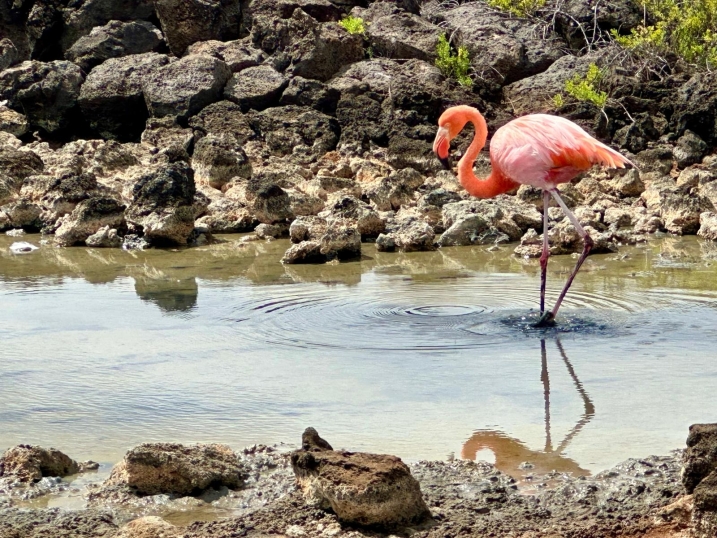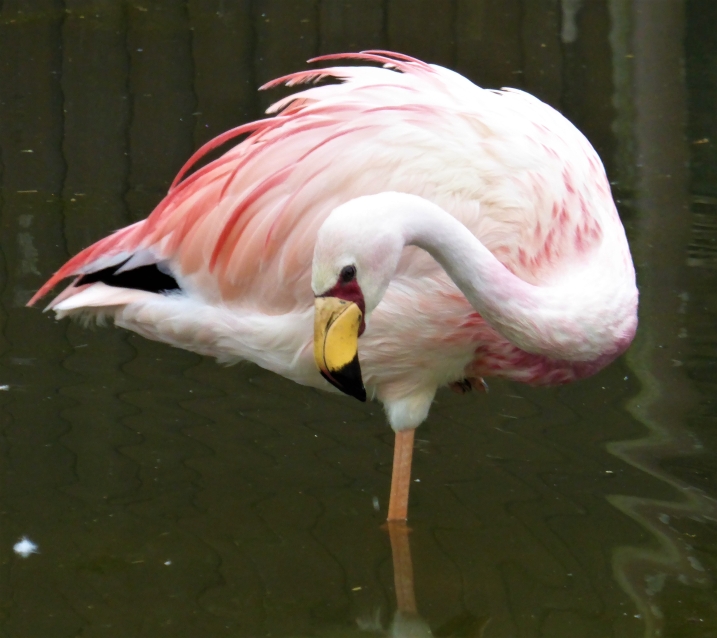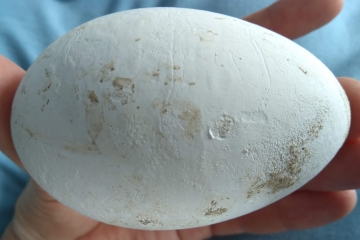What's so good in a flock?
Welcome to the first Flamingo Diary instalment of 2025! In this post, we will look at the importance of being in a flock to flamingo wellbeing. Even if that flock is made up of many different species. Of course, flamingos are famous for their striking pink feathers and their habit of standing on one leg. But beyond their eye-catching looks, flamingos have a deeply social nature. In the wild for example, they gather in vast flocks, sometimes numbering in the thousands and this natural instinct to live in groups is not just a quirky trait—it’s essential for their wellbeing. And this social behaviour needs to be translated into how flocks under human care are managed in zoos and wildlife parks. This is why you may see a “dolly mixture” group of flamingos on your next visit to WWT Slimbridge.
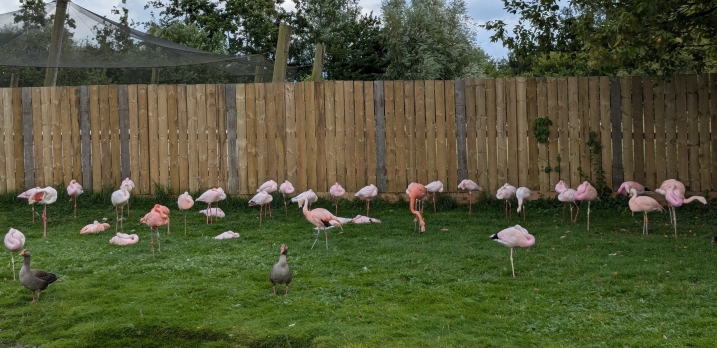
Who's currently at home in the Andean Flamingo Pen? See how many species you can spot on your next visit.
Because they are naturally social animals, being part of a group provides flamingos with security, companionship, and mental stimulation. In the zoo world, this mental stimulation is part of welfare-friendly husbandry and management practices termed “environmental enrichment” and creating a functioning social system really is enriching for flamingos. The large flocks that occur in the wild allows each bird to engage in complex social and courtship behaviours. These benefits continue in captivity, where living in groups—even if these groups include different species of flamingos—creates a diverse opportunity for social activities to occur.
Flamingos are highly communicative (you may have seen this in the array of vocalisation and interactions that occur between birds in the groups at WWT centres). Each individual relies on their flock to synchronise activities such as when to feed, preen, rest and nest. Keeping them in groups supports the outputs of such a natural behavioural rhythm (a bit like your daily routine of breakfast, going to work or school, coming home, socialising, having dinner, going to bed), as this regular pattern of activities helps support good welfare.
Next time you visit WWT Slimbridge, have a look in the Andean Flamingo Pen and you will see a colourful array of birds of different sizes, shapes and colours. From the diminutive lesser flamingo to the crimson Caribbean flamingo. In fact, depending on who is at home, there is a unique opportunity here to compare the form and function of five of the world’s flamingo species side-by-side.
The living collections staff at WWT Slimbridge closely monitor each flamingo flock to ensure the birds are thriving. By observing how individuals interact, or by tracking their food intake, and assessing how they use their enclosure, animal care can be tweaked and evolved to suits the needs of the flock. If a bird’s behaviour changes—such as a bird becoming isolated from the group, or an individual always showing aggression, or a flamingo that seems to be eating less—it can be an early sign that something isn’t quite right. For some of the old birds in our flocks, this may mean a move into a quieter environment (such as the Andean Flamingo Pen) where they can have a more peaceful existence. Thus, by keeping a close watch on flock dynamics, living collections staff can intervene when needed, ensuring a balanced and healthy social structure.
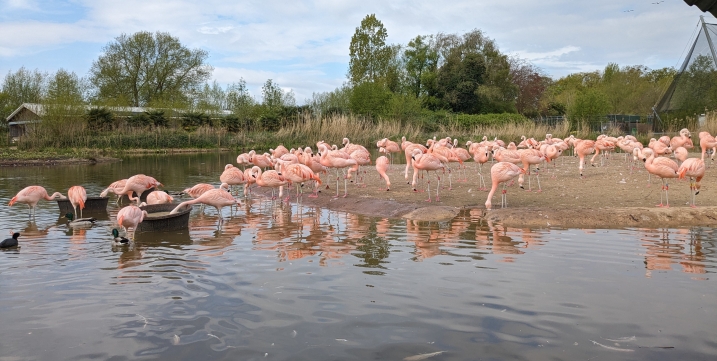
Some of WWT's flamingo flocks are big and noisy (just like in the wild) but as birds age, they may need somewhere more peaceful to go...
Just like people, flamingos sometimes want to be part of the crowd and other times need a little space. Providing a variety of feeding and resting areas within their enclosure allows them to make choices about where they want to be. Some birds may prefer to be in the middle of the group, while others may enjoy a quieter corner. Having these options reduces stress and helps maintain harmony within the flock. By designing enclosures that mimic the natural environment with different spaces for eating, preening, resting, and socialising, the flamingos have the freedom to interact in a way that feels comfortable to them. And because we know that our flamingos have individual personalities, this choice to do as they wish where they wish, helps foster a harmonious group dynamic.
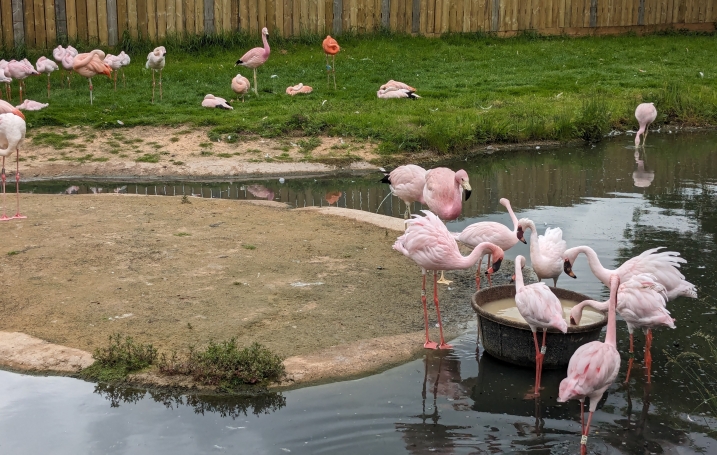
Who wants to feed and who wants to preen? Each WWT enclosure provides a range of resources for the birds, therefore they have choice over what they wish to do and when they would like to do it.
Ultimately, flamingos are at their best when they are surrounded by others, able to engage in their natural behaviours, and given choices in their daily lives. Whether in the wild or in managed care, their wellbeing depends on strong social bonds, attentive animal care staff, and thoughtfully designed environments. By understanding and supporting their social needs, we ensure these beautiful birds continue to thrive. So do spend some time to compare the flamingos in the Andean Flamingo Pen on your next visit, and spot some of the ways that this “mixed bag of birds” helps promote an interesting and engaging environment for all of these pink inhabitants of Slimbridge!
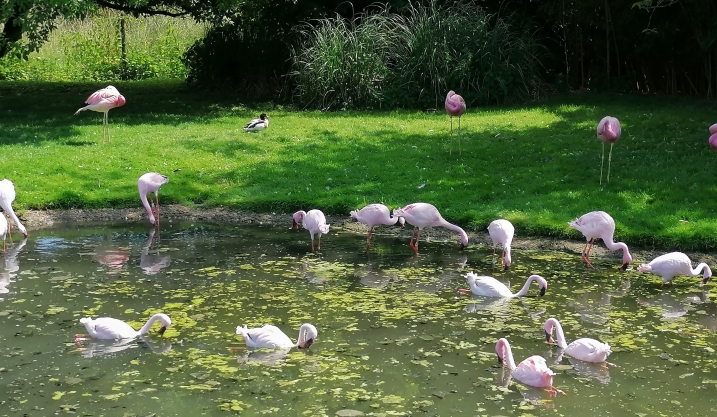
And sometimes we go swimming! Notice the lesser flamingos altogether paddling and filter feeding in the water, whilst there are snoozing Andean flamingos on the grass. Now look at the distance between the Andean flamingos. These birds have opted to close, or apart, from others. And this choice, even in a mixed flock, means the birds are in control of their daily time budgets.
